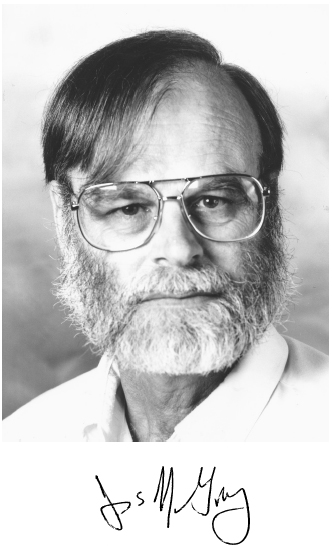
1944–2012
(Lost at sea in 2007)
Elected in 1995
“For contributions to the development and understanding of database systems, especially concurrent and distributed systems.”
BY DAVID DEWITT, ED LAZOWSKA, AND MIKE STONEBRAKER
JAMES N. GRAY, a leader in the field of database management systems, was lost at sea off the coast of northern California while sailing on January 28, 2007, at the age of 63. After a legally mandated waiting period, he was officially declared dead on Januar 28 2012.
Jim was born on January 12, 1944, in San Francisco, where he spent most of his childhood. He received his BS and PhD degrees from the University of California, Berkeley, in 1966 and 1969, and then worked at the IBM T.J. Watson Research Laboratory before joining IBM’s San Jose Research Laboratory. There he helped lead the design and development of System R, one of the first database systems to use the relational data model. He left IBM in 1980, worked for Tandem until 1990 on the parallel relational database system Non-Stop SQL, and then at Digital Equipment Corporation until 1995, when he joined Microsoft. At the time of his disappearance in 2007, he held the title of Technical Fellow at Microsoft.
In 1988, System R (along with the INGRES project at Berkeley) was honored with the ACM Software Systems Award, for pioneering the development of relational database systems. It was while working on the System R project that Jim first developed the notion of what it meant for transactions to be serializable, the connection between serializability and
database consistency, and how a protocol known as “two-phase locking” could be used to ensure that two or more transactions are serializable with respect to each other without having to understand the semantics of the transactions.
Jim’s pioneering research on transactions at IBM in the 1970s provides the foundation for today’s world of electronic commerce: every time someone uses an ATM, reserves a seat on an airplane, or purchases an item on the Web, they are relying on the mechanisms that Jim first developed. These techniques ensure that “the right thing” always happens, even in the presence of software and hardware failures. While they seem second nature today, when Jim conceived of them they required deep insight into the complexities of concurrently executing queries against a shared database system.
During his career Jim made a number of other significant technical contributions as well—database system architectures and algorithms, fault tolerance, input/output architectures, parallel database systems, database system performance evaluation and benchmarking, and multidimensional data analysis. Later in his career, he became interested in helping natural scientists with their work. As part of the Microsoft TerraServer and the Sloan Digital Sky Survey projects he put astronomy observation data into a database system, so scientists could query their data in SQL rather than writing custom programs in C++ or another general purpose language. The implementation of this idea for the Sloan Digital Sky Survey has resulted in more than 2,000 astronomy publications. The success of SQL also profoundly influenced how many scientists manage their data today.
Jim received numerous awards for his contributions to the database field, including the ACM A.M. Turing Award in 1998 for “seminal contributions to database and transaction processing research and technical leadership in system implementation.” In addition to being a member of the National Academy of Engineering, Jim was elected in 2001 to both the National Academy of Sciences and the American Academy of Arts and Sciences, and in 2003 he was elected to the European Academy of Sciences. He was in the first class
of ACM Fellows (1994), and served on President Clinton’s Information Technology Advisory Committee (PITAC), whose 1999 report had a significant impact on the nation’s investment in information technology research and development.
At a tribute event at UC Berkeley on May 31, 2008, 700 of Jim’s friends, family, and colleagues met to talk about his professional contributions and his impact on their lives. Speaker after speaker described his professional accomplishments in transaction processing and science applications as well as the ways that Jim had been a friend, mentor, and research collaborator. He was a mentor to many of the younger people in our field and traveled widely to universities and research centers to interact with research personnel.
Stories about Jim’s unique character are legendary. He was an unmanageable free spirit in the workplace, who could write prodigious amounts of code and even more prodigious research reports. He was almost never seen wearing a coat and tie and refused to conform to social norms. It was reported at the tribute that he had asked IBM to transfer him from Yorktown to San Jose so that he could work on System R. When his manager refused, Jim quit on the spot and drove across the country to be hired by the San Jose lab. Equally legendary are stories of his backpacking and hiking trips. He also loved to take people sailing on his boat, and it seems that half of the database community has had this pleasure.
Jim was a true scholar and friend of the entire database community. Those of us who knew him well will always strive to live up to the model that he set by his behavior.
He is survived by his wife Donna, daughter Heather, grandchildren Sam, Grant, and Nika, and sister Gail.
We miss him. He was one of a kind.




